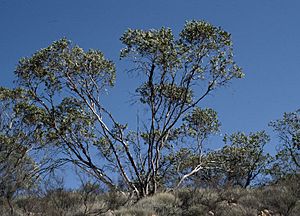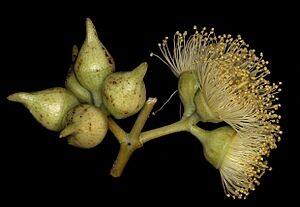Sharp-capped mallee facts for kids
Quick facts for kids Sharp-capped mallee |
|
|---|---|
 |
|
| Eucalyptus oxymitra on Mount Conner | |
| Scientific classification | |
| Genus: |
Eucalyptus
|
| Species: |
oxymitra
|
The sharp-capped mallee (Eucalyptus oxymitra) is a special type of mallee tree. It is found only in remote parts of Central Australia. This plant has rough bark on its trunk and smooth, grey bark higher up.
Its leaves are shaped like a spear or an egg. The sharp-capped mallee produces white or pale yellow flowers. These flowers grow in groups of seven. After flowering, it forms round, woody fruits.
Contents
What Does the Sharp-Capped Mallee Look Like?
The sharp-capped mallee is a type of mallee tree. It usually grows to be about 2 to 4 meters (6.5 to 13 feet) tall. This plant has a special woody swelling at its base called a lignotuber. This helps it regrow after fires.
Bark and Leaves
The bark on the main trunk is rough and greyish-brown. It peels off in ribbons. The bark on the branches is smooth and can be grey or cream-colored.
Young plants and new shoots have bluish-grey, egg-shaped leaves. These leaves are about 4 to 11 centimeters (1.5 to 4.3 inches) long. Adult leaves are a dull, greyish-green color on both sides. They are shaped like a spear or an egg. These leaves are typically 5.5 to 12.5 centimeters (2.1 to 4.9 inches) long.
Flowers and Fruit
The flower buds grow in groups of seven. They are found where the leaves meet the stem. Each group of buds sits on a stalk about 7 to 15 millimeters long. The individual buds are oval-shaped. They are about 11 to 16 millimeters long. Each bud has a pointed cap, which is why it's called "sharp-capped."
The sharp-capped mallee mainly flowers from October to January. Its flowers are white or a light yellow color. After the flowers, the plant produces woody fruits. These fruits are shaped like a half-sphere or a flattened sphere. They are about 5 to 12 millimeters long. The parts that hold the seeds stick out from the fruit's edge.
Where Does the Sharp-Capped Mallee Grow?
The sharp-capped mallee lives in open areas with shrubs. It grows on rolling sandy land and sand dunes. You can find it in the central Australian ranges. This includes the far eastern part of Western Australia, the southwestern Northern Territory, and the northwestern part of South Australia.
How Was the Sharp-Capped Mallee Named?
The sharp-capped mallee was officially described in 1936. A scientist named William Blakely gave it its formal name, Eucalyptus oxymitra. He wrote about it in a scientific paper.
The first samples of this plant were collected in 1894. This happened during an important trip called the Horn expedition. The name oxymitra comes from ancient Greek words. "Oxy" means "sharp," and "mitra" means "cap." This name refers to the pointed cap on the flower buds.
Is the Sharp-Capped Mallee Protected?
The government of Western Australia has looked at the sharp-capped mallee. They have classified it as "not threatened." This means it is not currently in danger of disappearing.


